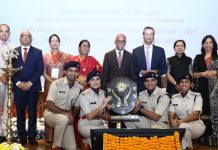On the night of March 31, J&K Police received information about the presence of the two militants at Dialgam in South Kashmir. The house in which they were holed up was immediately cordoned off. But before the security forces could engage the militants in an encounter which inevitably leads to their death, they tried to persuade them to surrender. They succeeded with one, who walked out with his arms and gave himself up. But another, Rouf Khanday stayed back.
Senior Superintendent of Police, Anantnag Altaf Ahmad Khan soon brought his parents who lived seven kilometres away to reason with him. Parents went inside the house but after half an hour they came out disappointed. Khanday had refused to surrender. Thereafter Khan too tried to talk him out of his intransigence but to no avail. An hour later Khanday was killed and body handed over to the parents.
The story has since become a part of the militancy folklore of the Valley. And also an advertisement for the new security strategy to tackle the growing militancy in the state. But not quite. On the day, Rouf was killed, twelve other militants, four civilians and three security personnel also lost their lives in two simultaneous encounters in the neighbouring district of Shopian. And there was no effort to persuade them to surrender, most likely because a large number of militants were present at the same place.
But the J&K DGP SP Vaid duly mentioned in an interview later the Khan’s efforts to ensure surrender of one militant at Dialgam and the unsuccessful attempt to persuade another to do the same. “No other country in the world will do it, give militant a chance to surrender once he is tracked down and cordoned off,” Vaid told a press conference.
However, this was not the first time that the security forces have brought the parents to secure the surrender of the trapped militants — albeit all of them have proved unsuccessful. In 2017 Lashkar-i-Toiba militant Mohammad Shafi Sher Gujri had refused to give up arms despite the desperate pleas of his wife who was brought to a village in Pulwama along with their one-year-old child.
And in 2016 only, an aged, frail father failed to persuade his son Showkat Ahmad, a militant, to surrender in similar circumstances. He was brought to the encounter site and despite his entreaties on a megaphone lasting several minutes, there was no response from the son. Also, in case of Dujana, a Pakistani militant, who was contacted by an Army officer immediately before the encounter with an offer to surrender, too failed to do so.
But this hasn’t dissuaded the security agencies to continue with the policy. Sources in the police say they are going to double down on the effort to try and secure the surrender of more militants as they see it more demoralizing for the militancy than killing them.
“Every funeral of a militant attracts thousands of mourners. This usually inspires more local youth to join militancy,” said a police officer. “But a surrender will certainly be a dampener. And in the process we also help save a local boy”.
But the surrender offer is largely exclusive to the local youth. According to the strategy, there will be discrimination in favour of the local militants: While there will be no mercy for the foreign militants who will be tracked down and killed, security agencies will make a conscious effort to persuade local militants to drop arms by engaging them either directly or through their families.
Success, however, has been modest so far. Except for the one militant who surrendered at Dialgam on April 1, no militant has given up arms when traced to his hide-out. But the security agencies have met with a reasonable success when it comes to reaching out to the militants on the run. According to an estimate, few scores of the militants have returned to their families after the appeal by their parents, either covertly or on social media. One such high profile case was that of footballer turned militant Majid Khan, who returned home on his mother’s appeal a week after joining Lashkar-i-Toiba in November last.
To further facilitate the “homecoming of militants”, J&K Police have even removed the need for them to report to police should they wish to do so. This has made new surrender policy too tempting to be easily resisted. But the reality remains that such surrenders have done little to setback the militancy. On the contrary, militancy has only shown signs of getting stronger by the day, replenished by the local recruitment and the infiltration. In 2017 alone, security forces killed 218 out of 282 militants — highest number in last seven years — but by the beginning of 2018, there were still 230 militants left. Around 117 local youth had taken up the gun last year. And in the past three months, around 30 more youth have joined militancy, police data reveal, and many more have gone missing.
What is more, highly educated youth are also taking up gun. On January 4, Manan Wani, a research scholar from Aligarh Muslim University joined militancy. He was pursuing his PhD in applied geology. Recruits like Wani
lend militancy more allure which, in turn, drives more recruitment. In March, son of the top Hurriyat leader Mohammad Ashraf Sehrai’s son Junaid Ashraf Khan, an MBA, also joined Hizbul Mujahideen.
Besides militants, on their part, have tried to stonewall the easy exit from their ranks by recruiting only the seemingly ideologically most motivated youth. They have developed their own rigorous rite of passage. A fresh recruit, said a police officer involved in counter-insurgency, has to get most of the basic things he would need as a militant. More often than not they are also asked to get weapons by snatching it from police men on security duty.
They are also required to announce their recruitment on Facebook so that all their ways of return are closed. This is what Mannan Wani did too. And so was done by Junaid Ashraf Khan.
“It is to pre-empt these difficulties of a militant to return to normal life that a flexible surrender policy has been devised,” said a police officer. “A militant can return to his family without feeling the need to report to police first. Similarly, before every encounter we are giving them a chance to give themselves up”.
But if the steady trajectory of the militancy over the past two years has underlined, the policy hasn’t made much of a redeeming difference.
Despite a small number of the militants returning to their families, they are outnumbered by far by the fresh recruitment. Overall, the militancy has only grown stronger and more motivated. “The security strategies like surrender policy aren’t going to help much,” says the columnist Naseer Ahmad. “This is just a tactical approach to the situation. Militancy in the Valley needs a strategic response and which is a serious political initiative to address the deeper historical and political factors underpinning it”.
letters@tehelka.com













